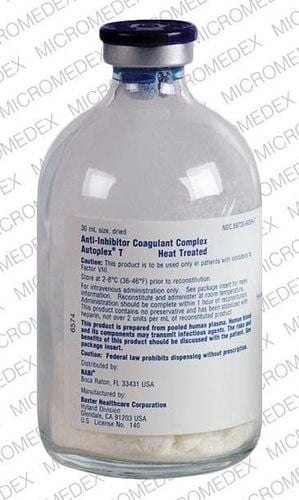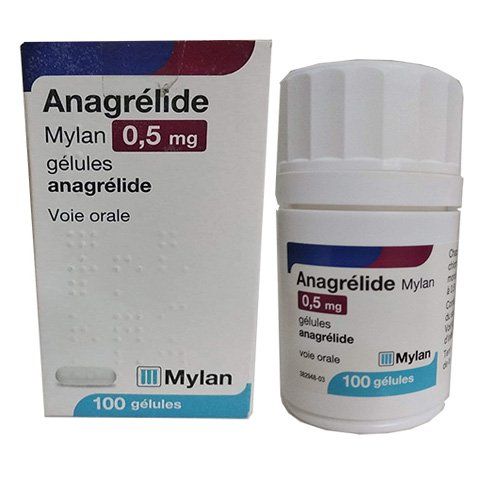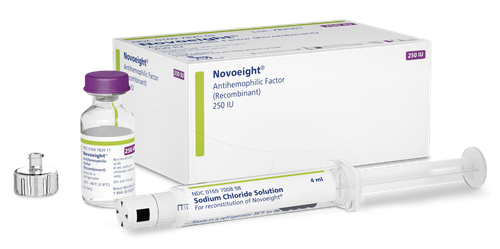This is an automatically translated article.
Xyntha Vial is a man-made form of clotting factor VIII. Xyntha Vial is used to control and prevent bleeding episodes in hemophilia A patients with low factor VIII levels.
1. What are the uses of Xyntha Vial?
Hemophilia A is an inherited bleeding disorder caused by a deficiency of clotting factor VIII or IX. For normal hemostasis, factors VIII and IX are required >30%, but most patients with hemophilia A have concentrations of these factors only <5%. Within hours of an injury, in people with hemophilia, blood can flow into deep tissues or joints, life-threatening. To diagnose hemophilia A, a quantitative test for specific clotting factors should be performed.
Xyntha Vial contains Antihemophil FVIII and B-Dom Del, which is a man-made form of factor VIII. It is used to control and prevent bleeding episodes in people with hemophilia A who have low factor VIII levels. Xyntha Vial is also used in these patients before surgery to prevent bleeding.
2. How is Xyntha Vial used?
Xyntha Vial is given intravenously as directed by your doctor. The dose of the drug is prescribed by the doctor depending on the patient's health condition and response to treatment. After the first sessions of medication, the doctor can instruct the patient to use the medicine at home. Patients need to clearly ask the doctor, pharmacist any unclear questions about how to use the drug, re-read the instruction sheet, learn how to safely store and dispose of needles and medical supplies after injection. whole.
If the medicine and diluent for injection are stored in the refrigerator, let the medicine and lip balm come to room temperature before reconstitution. After injecting solvent into the powder, rotate gently to completely dissolve the powder, taking care not to shake vigorously. Before use, visually check the clarity of the solution, do not use if the solution has residue or discoloration.
The dose of Xyntha Vial is prescribed by the doctor based on the health status, weight, blood test results and the patient's response to treatment.

Thuốc Xyntha Vial được tiêm vào tĩnh mạch theo hướng dẫn của bác sĩ
3. Side effects when taking Xyntha Vial
Common side effects when taking Xyntha Vial are flushing, headache, nausea, heart palpitations. These symptoms are usually relieved by slower injections. In addition, patients also often experience burning, redness, irritation at the injection site, fever, chills. Tell your doctor or pharmacist if these side effects are severe or persist.
Although very rare, patients need to be alert for severe allergic reactions to the drug. Get medical help if, after taking this medicine, you develop symptoms of a serious allergic reaction such as rash, itching, swelling, severe dizziness, chest tightness, difficulty breathing, etc.
In addition, tell your doctor if during the treatment with Xyntha Vial, the body appears side effects not listed above.
4. Precautions when using Xyntha Vial
Before using Xyntha Vial, tell your doctor if:
Allergy to anticoagulant factor VIII (Antihemophil FVIII, B-Dom Del) or other ingredients of the drug. Have a history of or are suffering from other medical conditions. Some other precautions when taking Xyntha Vial include:
Monitoring heart rate: If during injection, the patient's heart beats faster, need to reduce the infusion rate or temporarily stop the drug until the heart rate is normal. usually return. Pregnant women: Use Xyntha Vial during pregnancy only when clearly needed, when the doctor considers the benefits to outweigh the risks. Lactation: Current data do not indicate whether Xyntha Vial passes into breast milk. Therefore, consult your doctor when taking Xyntha Vial while breastfeeding.
5. Other notes when taking Xyntha Vial
To prevent possible interactions between Xyntha Vial and concomitant medications, patients should report all prescription and non-prescription medications to their doctor.
If you overdose on Xyntha Vial and have serious symptoms such as fainting, difficulty breathing, quickly take the patient to the nearest medical facility for timely emergency treatment.
Patients need to have blood clotting factors tested regularly so that the doctor can evaluate the effectiveness and adjust the dose of the drug accordingly.
Adherence to the dosing schedule is important in treatment. If you forget to take a dose of Xyntha Vial, contact your doctor immediately for a new dosing schedule. Do not take a double dose to make up for a missed dose.
Store the medicine according to the manufacturer's instructions. Do not freeze the medicine, do not store it in a place with high humidity. After mixing, only use the drug within the prescribed time. Keep medicine out of reach of children and pets.
Knowing the information about Xyntha Vial before use always brings positive effects as well as reduces risks for patients. If you have any questions, you can send them to Vinmec International General Hospital to receive in-depth advice from a team of doctors and pharmacists with many years of experience.
Please dial HOTLINE for more information or register for an appointment HERE. Download MyVinmec app to make appointments faster and to manage your bookings easily.
References: webmd.com, msdmanuals.com













